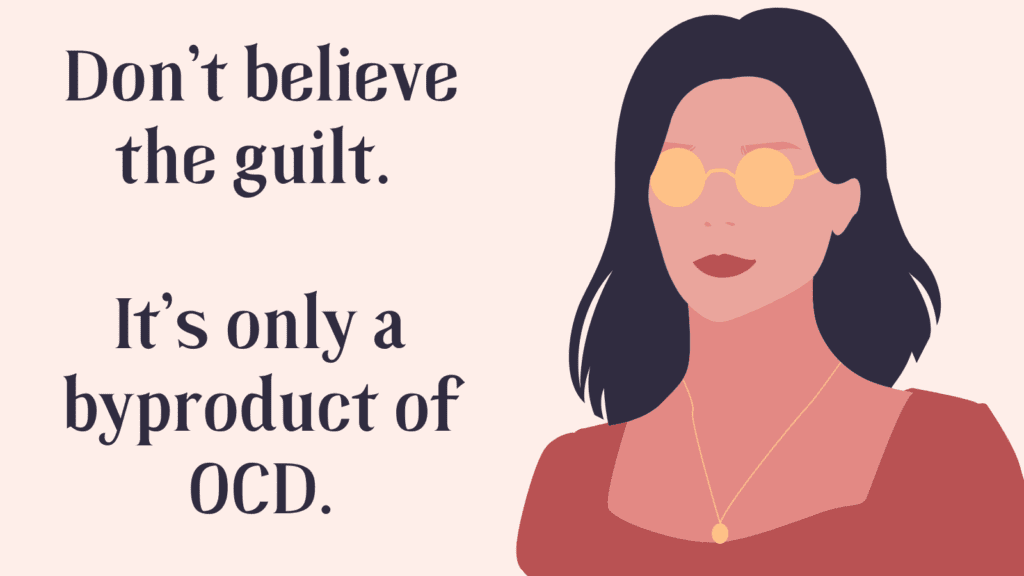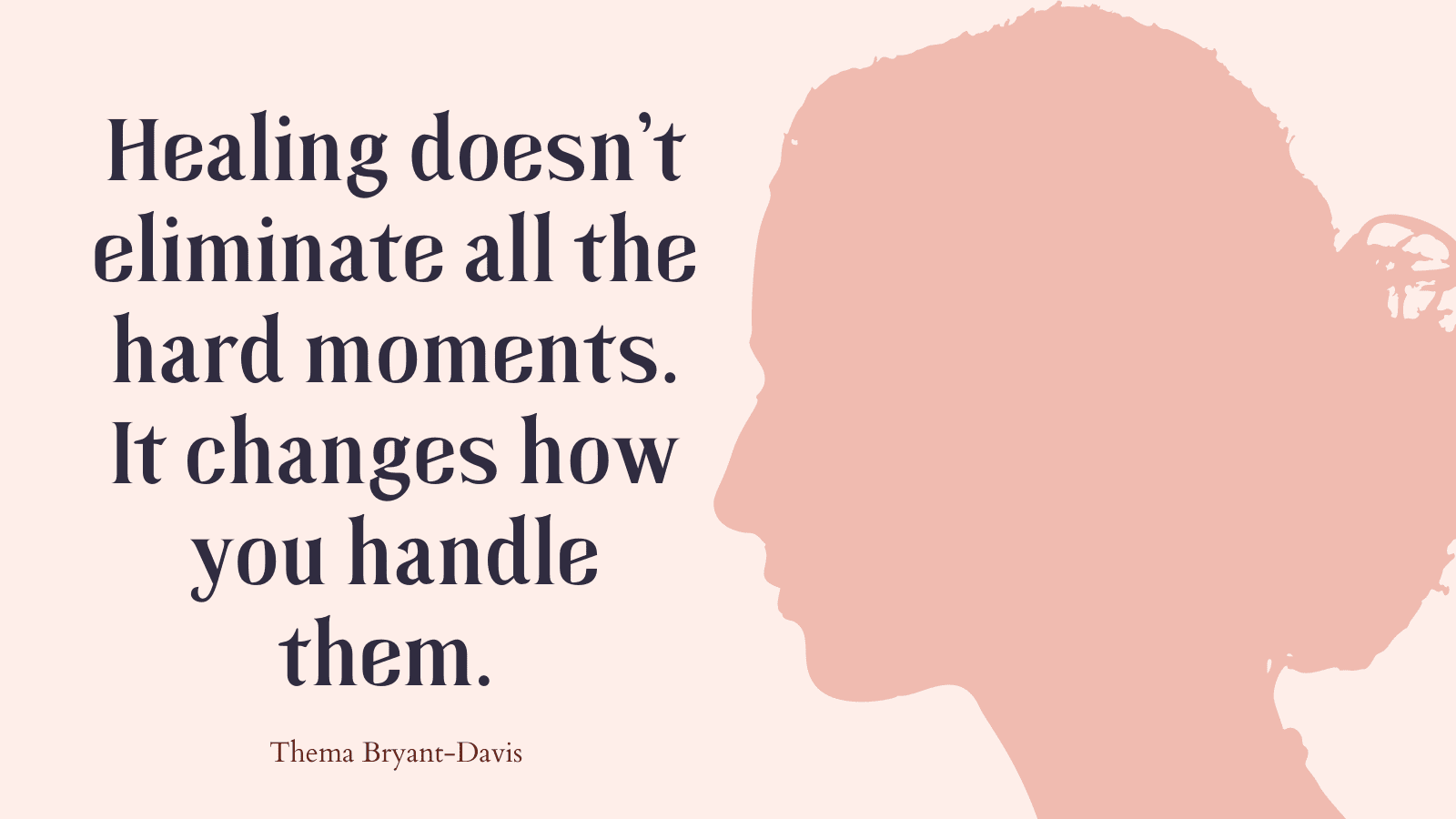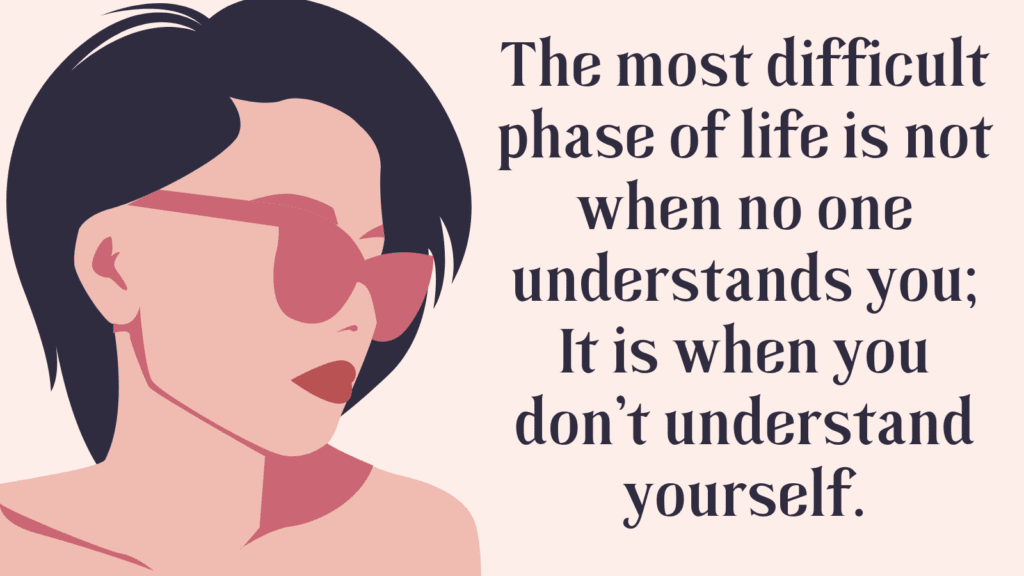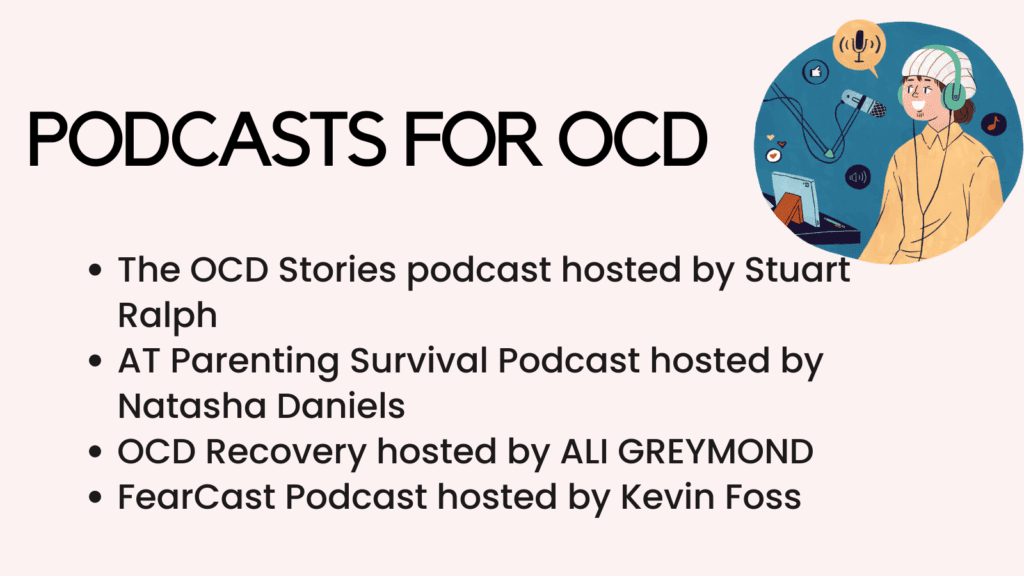Today, you’re going to learn all about dealing with OCD without meditation using cognitive behavioral therapy (CBT).
For many people, Obsessive-Compulsive Disorder (OCD) seems like a behavioral quirk.
OCD has even become somewhat of a common term thrown around lightly to tease anyone who feels the need to be orderly.
The truth is OCD is much more than that.
It is a severe and crippling illness, characterized as much by the mental torment of recurring intrusive thoughts as repetitive physical actions such as repeated hand-washing and checking.
On average, people who suffer from OCD can waste up to six hours a day on their obsessions and four hours on their compulsions. (*) (*)
Obsessive-Compulsive Disorder (OCD)
Obsessive-Compulsive Disorder (OCD) is a chronic mental illness that affects over 2.2 million people in the USA alone.
OCD is the fourth most common mental disorder after depression, substance abuse, and anxiety.
People with OCD suffer from intrusive and unsettling thoughts or urges that often compel them to engage in repetitive, ritualistic behaviors.
Understandably, this mental illness can cause a great deal of distress over feeling stuck in obsessions and compulsions.
In severe cases, it can be hard for the person to think about anything other than their obsessions.
OCD is a form of anxiety, that wrongly makes people believe that the only way to alleviate their anxiety is by giving in to their compulsions. Which it does, but it also creates a much more complex problem, as it takes away the person’s sense of control over their lives. (*)
Self-Assessment: Do I Have OCD?
The following are some of the symptoms people commonly experience as part of OCD:
1. Unpleasant thoughts come into your mind against your will and you cannot get rid of them.
2. You ask people to repeat things to you several times, even though you understood them the first time.
3. You constantly have to review mentally past conversations and actions to make sure that you didn’t do something wrong.
4. You check things more often than necessary.
5. You collect things you don’t need or avoid throwing anything away because you are afraid you might need it later.
6. You get upset if objects aren’t arranged properly and feel obliged to arrange them.
7. You are excessively concerned about cleanliness.
8. You avoid using public toilets because you are afraid of disease or contamination.
9. You feel obliged to follow a particular order in dressing, undressing, or washing.
10. You feel compelled to count while you are doing things.
11. Even after doing something carefully, you still feel you haven’t finished it or made a mistake. (*)
If you checked one or more of these symptoms and it’s causing you significant distress and/or it’s interfering in your ability to work, study or maintain your social or relationships, then you might need to discuss your symptoms with your doctor.
Three Key Aspects of OCD
Depending on the particular obsessions or compulsions of the individual, OCD can have different symptoms.
1. Obsessive Thoughts
Some of the most common obsessive thoughts include:
Orderliness and symmetry – excessive worrying about the neatness and tidiness of everything.
Contamination – excessive fear of being contaminated with germs and bacteria.
Rumination – In the context of OCD rumination is actually a train of prolonged thinking about a question or theme that is undirected and unproductive. Many ruminations dwell on mistakes that one has done or might do, and so on.
Checking – this kind of obsessive thought leaves the person wondering if they’ve already turned off the lights, turned off the stove, locked the windows and doors, etc.
Dark Thoughts – this induces a fear of even thinking about “sinful” or bad things.
Violence – a person with these thoughts often fears causing harm to others, even though they do not want or intend to.
Although OCD is usually associated with external behaviors like checking and washing, these behaviors are usually responses to your thoughts and what you think about your thoughts. (*)
2. Compulsions
Some of the most common compulsive behaviors include:
- Skin-picking
- Hair-pulling
- Hoarding/accumulating “junk”
- Repeated hand washing or cleaning
- Repeating certain words
- Performing certain tasks repeatedly
- Constant counting
Although there are different types of obsessions and compulsions, what is effective in treating one type of OCD is also effective for the rest as well.
3. Avoidance
A third key aspect of OCD is avoidance of obsessions’ triggers.
Each time you avoid a situation or an activity, you prevent yourself from experiencing anxiety and facing the fear of what you think could happen. Thus the fear increases and the behavior is reinforced.
How your thoughts, emotions, and behaviors can interact and intensify OCD?
- Feelings of anxiety can increase the vividness and frequency of your worrisome thoughts.
- Feelings of guilt may cause you to think of yourself as a bad person for having these thoughts.
- Repetitive checking overloads your short-term memory and makes it even harder to feel certain and decreases your trust and confidence in your own mind.
- Avoidance intensifies your fear.
Try This: Identify Your Problem
Spend a few minutes every day to identify your triggers – the places, people, items, activities, and so on that activate your obsessions.
Write down how you respond to help yourself feel better.
By identifying your problem, you’ll be able to solve it more effectively.

Dealing With OCD Without Medication: Cognitive Behavioral Therapy (CBT) For OCD
What Is Cognitive Behavioral Therapy?
Cognitive Behavioral Therapy – or CBT is a short-term, goal-oriented psychotherapy treatment that takes a practical approach to problem-solving.
The guiding principle behind CBT is that our thoughts determine our feelings and behaviors. By correcting or changing your distorted thoughts, you’ll be able to change your feelings and behaviors.
CBT is used to help treat a wide range of issues in a person’s life, from sleeping difficulties or relationship problems to anxiety and depression and even OCD. (*)
Cognitive-Behavioral Therapy CBT is one of the most effective kinds of therapy that can treat OCD patients and alleviate their anxiety.
Treatment involves some form of deliberately facing your fears and stopping your rituals. Treatment may or may not include medication, depending on what you and your doctor decide.
#1. Understand Your Thinking Patterns
1. Two Types of Thoughts You Need to Be Aware of
There are two distinct kinds of thinking:
1. Automatic thoughts (also referred to as intrusions) that pop into the mind on a regular basis without you deliberately trying to think them.
For example, you may be reading a book, read one expression, and remember a song that had that expression in its lyrics. You didn’t intentionally think about this topic, but something triggered the thought.
Sometimes, thoughts can’t be easily traced to a trigger.
For example, you may be working on a project and randomly think of a friend of yours.
2. Response Thoughts: (referred to as metacognition) that you do in response to your automatic thoughts – a second level of thinking.
These thoughts are less random and you have more control over them.
For example, when you find yourself randomly thinking about your friend, you may respond to this thought by thinking about it. You may think, “I wonder what he has been doing lately.”
You could also choose not to respond to the automatic thought and bring your focus back to whatever you’re doing at the moment.
2. What About Intrusive Thoughts?
Intrusive thoughts are one form of automatic thoughts, but they tend to catch your attention more because their content is usually unusual, weird, or alarming.
Everyone experiences automatic thoughts. Some people may have more of them or maybe more aware of them, but everyone has them to some extent.
What some people find intrusive, may be dismissed as an automatic thought by other people. But typical subjects for intrusive thoughts may include; violence, causing harm (accidentally or deliberately), illness, death, contamination, sexuality, and superstition.
One of the main ways OCD pushes you to respond to intrusive thoughts is by persuading you that this thought is really important and needs responding to.
Related: 10 Powerful Techniques To Control Your Negative Thoughts
Try This
OCD is characterized by a need for certainty and sometimes perfectionism.
Rather than trying to reassure yourself, think of this as an exercise in figuring out how to tolerate doubt and challenge yourself not to recheck or engage in any compulsive behavior, even if you’re not absolutely sure.
3. How Intrusive Thoughts Become Obsessions?
An intrusive thought isn’t an obsession – no matter the content. It’s still an automatic thought that caught your attention more than the other automatic thoughts.
However, when you add an unhelpful negative interpretation to the thought, in a way that leads you to react differently, then it becomes an obsession.
This negative interpretation or appraisal usually involves:
- A belief that you should not have the thought, and;
- A belief that having the thought must mean something bad.
But the truth is, a thought is just a thought. It doesn’t necessarily mean anything about anything.
4. Why Obsessions Centre On Out-Of-Character Ideas?
Automatic thoughts are noticed as intrusive thoughts because their content is usually out of character and goes directly against everything the person holds true. The person, therefore, attaches meaning to it.
You might find yourself thinking, “I shouldn’t have these thoughts,” or, “Having such thoughts must mean something bad.”
This will prompt you to look for more thoughts with that content, creating a vicious circle.
#2. Manage Your Intrusive Thoughts
1. Refrain From Replacing Intrusive Thoughts With a Helpful, Positive One
By replacing these intrusive thoughts with positive ones, you’re still giving them attention. Furthermore, the positive appraisal can become a way of trying to reassure yourself.
The goal is not to replace the intrusive thoughts with positive ones.
Rather, the goal is to help enable you to barely notice these intrusive thoughts coming in and out of your mind and not to think about them when you do notice them.
2. Let Go Of Using Your Feelings As A Guide
People often use their emotions as a guide for assessing their automatic thoughts. For example, if you feel fear, you assume that you are in danger. If you feel guilt, you assume that you must have done something wrong.
While strong emotions like fear, anxiety, and guilt help alert us to a problem, when you have a disorder like OCD, this natural self-preservation mechanism begins to over-function and ceases to serve a useful function.
To reset the balance, you need to practice not responding to these emotions or using them to give importance and meaning to your automatic thoughts.
Try This
Imagine having an OCD-free twin and each time you’re about to participate with your OCD, ask yourself the question, ”What would my OCD-free twin do in this situation?”
3. Correct Distorted Beliefs About Your Thoughts
Growing up, most people have been told that they shouldn’t do or say ‘bad’ things, often coupled with “You shouldn’t even think things like that!”
This is why people would place importance on the random thoughts that pop into their minds and try to control them.
Unfortunately, trying to control what pops into your head, can lead to an unwinnable war with your own brain. And because you can’t control what automatic thoughts pop into your head, believing that should not have them makes no sense.
Your OCD may make you think, “If I was a good person, I wouldn’t have had these thoughts,” or that “They must mean something.”
The truth is these thoughts might be against what you want to think, but they don’t mean anything.
Just because you had a thought of harming someone, for example, doesn’t mean that you’re more likely to do it.
It takes more than thoughts for you to take action. There are other factors like desire and motivation.
You choose whether to act on your thoughts or to dismiss it.
Try This
Think about how hard it is to get yourself to do something when you really don’t want to.
Simply having the thought ‘go study’ when you don’t want to, is unlikely to make you do it. You’ll probably look for all kinds of excuses to leave it for later.
Life would have been so simple if a thought alone could actually make you do the thing you think of. You won’t procrastinate, or work yourself up to things.
What Doesn’t Work When Dealing With Obsessions?
It’s not the thoughts but rather what you do with them that maintains the OCD cycle.
Obsessions are automatic thoughts that you notice and attach meaning to.
One of the most common meanings is that you shouldn’t have these thoughts and that having them means something bad.
These obsessions trigger feelings of discomfort that push you to engage with them in an attempt to reduce the discomfort.
Unfortunately, the more you engage with these thoughts the more you add importance to them and feed the OCD’s desire for attention.
Here are some common ways you might be engaging with your obsessions:
1. Rationalizing
You rationalize when you try to convince yourself that the obsession is wrong by providing arguments against the thought.
This is a common technique in CBT where you identify ‘thinking errors’ and look for rational arguments to correct these distorted thoughts.
Unfortunately, this doesn’t work with OCD. No matter how many rational arguments you can provide, you still won’t feel 100 percent convinced. You’ll never have the last word.
2. Reassurance
Reassurance is when you try to convince yourself that the thought isn’t true or that something bad isn’t going to happen.
This is also another form of engaging with your obsessions that doesn’t work in the long term.
Instead, you need to learn how to live with the doubt and let it subside on its own.
3. Checking
This is when you mentally review things to make yourself feel more certain and alleviate your anxiety.
This is unhelpful and doesn’t work in the long term, which is why you’ll often check more than once.
In fact, checking-driven data you put into your mind overloads your short-term memory and prevents the information from moving to long-term memory, which is why people with OCD so often seem so unsure about the things they have checked.
4. Suppressing Thoughts
Trying very hard to suppress obsessions can be as unhelpful as engaging with them.
Some of the reasons why thought suppression doesn’t work include the following:
- Trying not to think about something makes you more likely to think about it.
- It reinforces the distorted belief that you shouldn’t be thinking about this.
- It gives the thought more attention and importance.
5. Avoiding Triggers
One of the most common ways people use to prevent certain thoughts is avoiding triggers.
Although avoidance may work in the short term, it reinforces unhelpful beliefs about the unacceptability of thoughts and your inability to cope with them, which keeps you stuck.
The more you avoid, the more you become convinced that these thoughts are wrong and that the only way you can cope with them is through avoidance.
6. Pushing Thoughts Away
This is when you try to force thoughts out of your mind when you notice them by:
- Distracting yourself with something else
- Imagining yourself putting the thought in an imaginary closet or garbage can.
- Saying ‘Stop’ or snapping a rubber band on your wrist.
Distracting yourself to get rid of the thoughts is different from the helpful alternative of letting the thought be there and refocusing your attention on something else.
Why Pushing Thoughts Away Doesn’t Work?
Imagine yourself pushing a closed door while trying to ignore it. Chances are, the only thing you will think about is that door.
In the same way, trying to push your thoughts away will make you think about them even more.
A much easier way to ignore a thought is to stop pushing it so you’re no longer in contact with it.
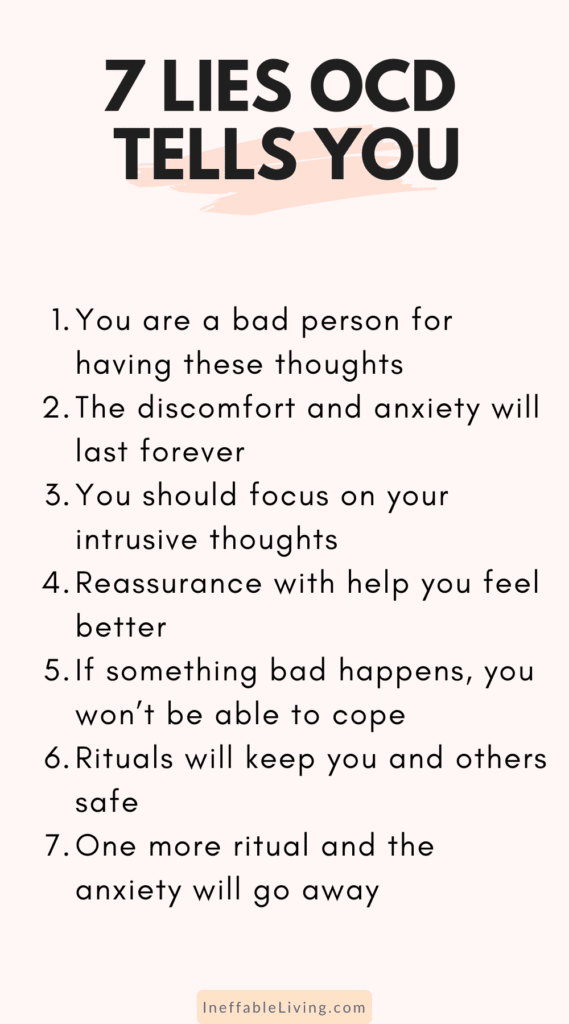
How To Stop OCD Thought Loops?
1. Detached Mindfulness: Change Your Attitude Toward Your Thoughts
The best way to deal with obsessions is to do nothing.
Detached mindfulness or mindful detachment refers to the process of being aware (mindful) of your thoughts whilst separating yourself from them (detachment).
This practice helps you learn to take a step back and become an observer of these thoughts rather than becoming involved with them.
Mindful detachment helps you see your thoughts and sensations for what they are, simply internal events, without judging them as right or wrong, true or false.
If the day is cold, you think “Today is cold.” It’s a thought about a fact that’s neither right nor wrong – it is what it is.
In other words, detached mindfulness helps you change your relationship with your thoughts. Instead of fighting them, you learn to let them be there without feeling the need to do anything.
Try This
Think of intrusive thoughts as trains passing through a busy station. You’re a bystander on the platform simply watching these trains come and go without having to get on any of them.
You don’t need to stop the trains. You just let them do their own thing without getting involved.
2. Start Redirecting Your Attention
Having OCD, you’ve likely trained yourself to be very attentive to the thoughts that you don’t like.
Luckily, you can retrain yourself and start paying less attention to these thoughts.
Try This
Using sounds, start practicing redirecting your attention by strengthening your ability to choose where you direct your attention.
Set aside 10 minutes every day to do this exercise:
1. Choose three different sounds to listen to at the same time.
For example, you can play a song on your phone or computer, turn on the television, use traffic noise, or building works.
Whatever sounds you choose, make sure they’re coming from different sources and different directions. Attach a number to every sound.
2. Sit back with your eyes open and softly focus on point or an object in front of you.
3. Pay attention to sound number one for a minute or two.
The goal here is not to block out the competing sounds but to keep redirecting your attention to the chosen sound each time your mind wanders off.
4. Switch your attention to the next sound and repeat the same process.
Once you’ve mastered this exercise at home, try doing it throughout the day to practice maintaining and redirecting your attention.
3. Redirect Your Attention Outside of Your Head
When you’re stuck focusing on what’s going on inside your head or body, you stop being present and miss out on what’s going on around you.
Daydreaming or ruminating may be harmless when it’s occasional.
The problem is when the majority of your day is spent with your focus directed inward.
This is mainly because focusing on your thoughts and sensations adds more importance to them and they become more consuming. It also prevents you from engaging fully with your environment.
How to redirect your focus outside your head?
The first step to redirect your focus is to pay attention to it.
Once you realize when you’re focusing on what’s going on inside, you can choose to direct your focus elsewhere.
Try This
Set a reminder every hour to ask yourself what were you paying attention to. Was your focus internal or external? Helpful or unhelpful?
The more you practice checking in with yourself, the more you develop awareness of when your focus is internal and unhelpful.
As you get better at noticing your focus, make the reminders less frequent, until you become able to notice your focus without needing reminders.
Start redirecting your focus outside of yourself. If you’re in the middle of doing a certain task, fully engage with that task. If you’re in the middle of a conversation, redirect your focus to what the other person is saying. If you are on a train, redirect your focus to the sounds around you.
What’s the difference between distraction and redirection?
It’s about your intention.
When you distract yourself from your OCD thoughts and feelings, you’re trying to fight them and escape them, which is a form of avoidance that only makes the problem worse in the long run.
However, when you redirect your attention elsewhere, you’re allowing these thoughts and feelings be there, but choosing not to engage with them.
#3. Use Positive Self-Talk
You might not be aware of this, but you’re constantly practicing self-talk. It’s the monologues in your mind that go on from the moment you wake up to the moment to go to bed.
In Cognitive Therapy, self-talk is practiced deliberately by choosing positive and encouraging affirmation that you repeat to yourself as you process your personal experiences.
In the example stated above, you can remind yourself that you’re not your disorder. That you’re not a bad person, and that it’s your OCD that’s making you think these terrible things. Simply observe your thoughts and remind yourself that they don’t control you.
Repeat positive affirmations like, “I am kind, caring, and compassionate,” or, “I am in control of my thoughts.”
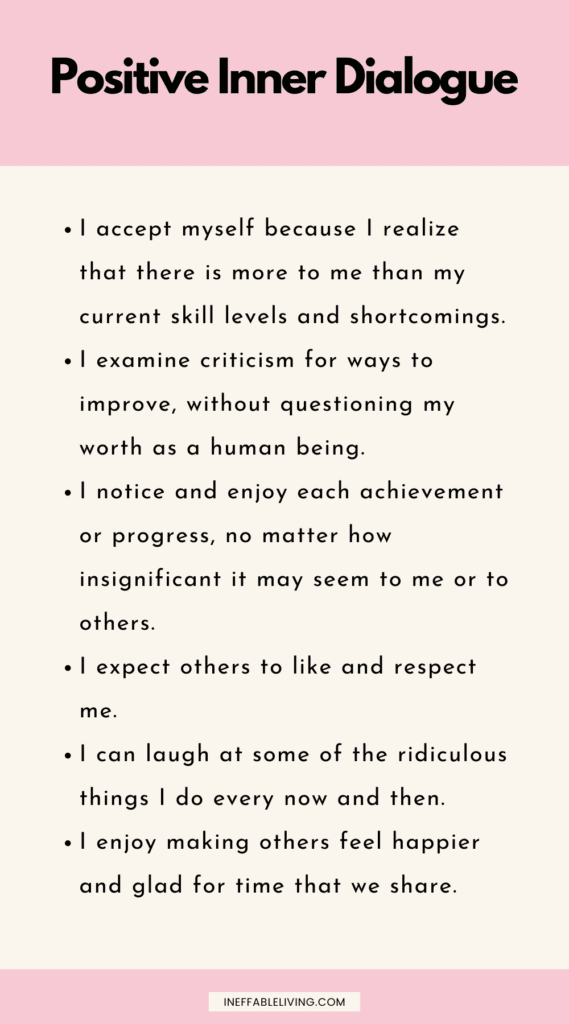
#4. Exposure and Ritual/Response Prevention (EX/RP)
EX/RP is a CBT technique that helps in managing obsessions and decreasing compulsions of OCD patients. It has been used since the 1950s and has been shown to be extremely effective when applied correctly.
1. Exposure
The exposure part of ERP involves gradually exposing yourself to situations that trigger your obsessive thoughts and compulsive behaviors to allow anxiety or discomfort to come down on its own (a process called habituation).
For example, if you avoid touching something for fear of contamination, using exposure by touching that thing repeatedly will help you becomes less afraid of it.
2. Response Prevention
The response prevention part of ERP involves stopping yourself from performing your usual response you use to try to keep yourself safe or alleviate discomfort in any way.
Over time, the frequency of your compulsions and the intensity of your obsessions will decrease.
For example, if you have a fear of contamination and you usually respond by trying to replace your intrusive thought with more positive ones, the response prevention part of ERP will require you to allow the intrusive thought to stay in your head instead without engaging with it in any way.
3. Doing The Opposite Of What The OCD Wants
A third part to apply ERP successfully is to deliberately do the opposite of what the OCD wants you to do.
This will make refusing to engage in the rituals easier.
For example, if you worry about contracting HIV by touching something you think is contaminated, applying ERP will look like the following:
1. Touching the things you usually avoid
2. Refrain from washing your hands
3. Deliberately spread the contamination by touching your clothes and other common objects, like a phone, kitchen table, etc.
Try This
Think of deliberate exposures as standing up for yourself against OCD and telling him, “Really, OCD, you don’t want me to do that? Well, I’m doing it anyway!”
What if I don’t have any compulsions?
Pure O, as in ‘purely obsessional’ also referred to as rumination OCD is one type of OCD that appears to be different from other forms of OCD with obvious compulsions (washing or checking).
However, pure O also involves compulsions that are often overlooked. They are of mental nature, such as trying to suppress an obsession or replacing an intrusive thought with a positive one.
Once you identify compulsions you use to relieve your worrying, you can use the ERP formula.
For example, if you usually try to replace a negative thought with a positive one, applying ERP you may choose not to do so but also deliberately think of similar thoughts that are as negative or even more negative.
#5. Use Imaginal Exposure (IE)
Because OCD is a complex and wide mental illness, some treatments might not work for certain OCD obsessions.
Exposure and Response Therapy encourages individuals to, gradually, expose themselves to situations that trigger their obsessive thoughts.
This can work for someone who suffers from obsessive thoughts about getting germs from touching a doorknob, by allowing themselves to touch doorknobs without washing their hands. But it is not applicable for someone who suffers from obsessive thoughts about losing loved ones.
In this case, they can undergo Imaginal Exposure. IE helps individuals visualize different scenarios that train them on how to react to these situations.
1. Identify a particular situation that triggers your OCD (for example, losing your loved ones)
2. Imagine yourself in the situation (or look at it for distance). Picture that specific scenario over and over again until you feel less triggered by it.
3. Remind yourself that it’s not reality and that it won’t happen.
By comforting your worst fears, your level of anxiety and the intensity of your emotions will slowly diminish.
Another alternative to Imaginal Exposure is writing imaginative stories. Through writing your fears, you can expose yourself to OCD triggers and face your negative thoughts.
OCD Affirmations
I am in charge of my mind
I have power over OCD
I control impulses and obsessions
I resist compulsive urges
I am in control of my thoughts
#6. Reclaim Your Life from OCD
If you have been living with OCD for a while, chances are it has become a major part of your life.
The thought of letting go of the need to fight and engage with your OCD might make you wonder who you are if not your illness.
1. Define Your Values
Defining your values is the first step in reclaiming your life from OCD.
Values define what’s important to you and what you want your life to be about. They’re not goals to be achieved, rather a compass pointing you in your chosen direction.
For example, if family is one of your values, you may start setting goals for yourself to deepen your relationship with your family, by spending more quality time, having emotionally intimate conversations, etc.
The following is a list of values to inspire from:
How to define your values? Try This
One good way to define your values is to visualize looking back across your life from your deathbed.
What do you think you’ll need to feel you’ve lived well?
How well does your current life fit in with living that way?
What do you want people to remember you for?
FAQ
What Causes OCD?
As with many other psychological problems, no single type of person develops OCD.
However, researchers have identified some psychological traits that are associated with vulnerability to OCD:
- Perfectionism
- Intolerance of uncertainty
- Excessive need to be in control
- Overestimating the accuracy of thoughts
Can OCD Be Cured?
Recovering from OCD shouldn’t be viewed in a black-or-white way.
Here’s what a full recovery from OCD means:
- Your intrusive thoughts are significantly less intrusive, less frequent, and last for far less time.
- The levels of distress related to obsessions have become less significant and less frequent.
- You obsessions no longer prevent you from engaging in important areas of your life.
- You rarely find yourself engaged in compulsions.
- You allow yourself to experience your thoughts, images, doubts and urges, without focusing on them.
What Causes OCD To Get Worse?
There is no single cause of OCD getting worse, as it can be influenced by a variety of factors.
However, some common triggers that can make OCD symptoms worse include:
1. Stressful life events: Any major life changes, such as a death in the family, divorce, or job loss, can trigger or worsen OCD symptoms.
2. Lack of sleep: Sleep deprivation can make people more anxious, stressed, and less able to deal with OCD symptoms.
3. Substance abuse: Certain drugs and alcohol use can exacerbate OCD symptoms.
4. Lack of treatment: If someone with OCD is not receiving proper treatment or is not complying with their treatment plan, their symptoms may become worse.
It’s important to remember that OCD symptoms are different for everyone and can be triggered by various factors.
Looking for more techniques to help you deal with anxious thoughts? Check out this article: 10 Powerful Techniques To Control Your Negative Thoughts
Resources
- Portions of this article were adapted from the book Cognitive Behavioral Therapy: The 21 Day CBT Workbook for Overcoming Fear, Anxiety And Depression, © 2019 by Jacob Greene. All rights reserved.
- Portions of this article were adapted from the book The Man Who Couldn’t Stop, © 2014 by David Adam. All rights reserved.
- Portions of this article were adapted from the book Break Free from OCD, © 2011 by Fiona Challacombe, Paul Salkovskis, and Victoria Bream Oldfield. All rights reserved.
- Portions of this article were adapted from the book Managing OCD with CBT For Dummies, © 2016 by Katie d’Ath and Rob Willson. All rights reserved.
- Overview – Obsessive compulsive disorder (OCD) – NHS (www.nhs.uk)
- Obsessive-compulsive disorder (OCD) – Symptoms and causes – Mayo Clinic
- International OCD Foundation | What is OCD? (iocdf.org)
- NIMH » Obsessive-Compulsive Disorder (nih.gov)
- OCD: Types, Symptoms, Causes, Diagnosis, Treatment, and Related Conditions (webmd.com)
- Obsessive–compulsive disorder – Wikipedia
- Psychiatry.org – What Is Obsessive-Compulsive Disorder?
- OCD (Obsessive-Compulsive Disorder): Symptoms, Causes, Treatment (healthline.com)
- What is OCD? – Mind
